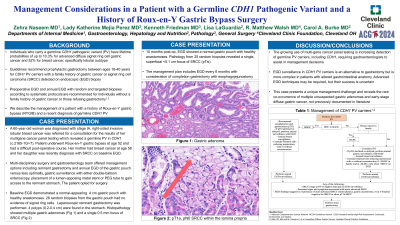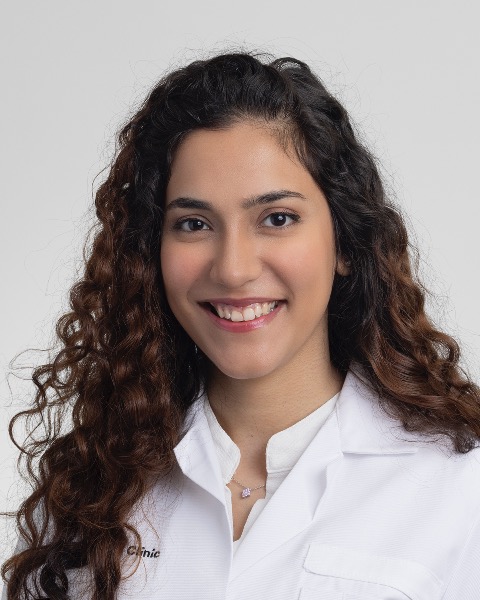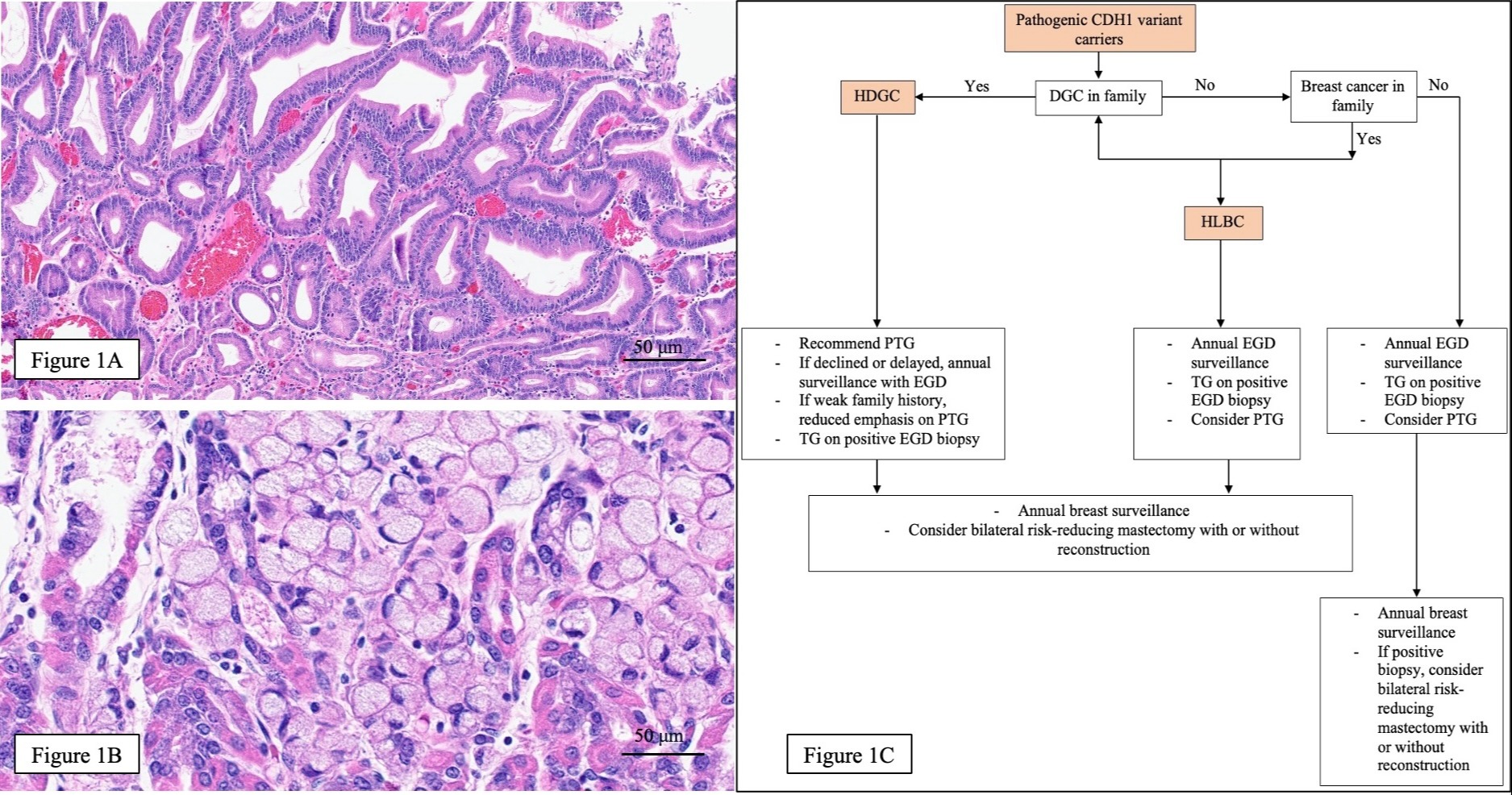Tuesday Poster Session
Category: Stomach
P5080 - Management Considerations in a Patient With a CDH1 Pathogenic Variant With a History of Roux-en-Y Gastric Bypass Surgery
Tuesday, October 29, 2024
10:30 AM - 4:00 PM ET
Location: Exhibit Hall E

Has Audio

Zehra Naseem, MD
Cleveland Clinic
Cleveland, OH
Presenting Author(s)
Zehra Naseem, MD1, Lady Katherine Mejia-Perez, MD2, Kenneth Friedman, MD1, Lisa LaGuardia, RN2, R. Matthew Walsh, MD1, Carol A.. Burke, MD, FACG2
1Cleveland Clinic, Cleveland, OH; 2Digestive Disease Institute, Cleveland Clinic, Cleveland, OH
Introduction: Individuals carrying a CDH1 gene pathogenic variant (PV) have a significantly elevated cancer risk, with lifetime probabilities of 40-83% for diffuse gastric cancer (DGC) and 40-55% for breast cancer. Guidelines recommend prophylactic gastrectomy between 18 - 40 years in CDH1 PV carriers with a family history of DGC. Annual endoscopic (EGD) surveillance with random and targeted biopsies to detect signet ring cells according to the Cambridge protocol is the alternative in those refusing gastrectomy. We discuss our approach to the management of a CDH1 PV patient who previously underwent Roux-en-Y gastric bypass (GIB).
Case Description/Methods: A 60-year-old woman with a prior Roux-en-Y GIB 8 years ago underwent a 55-gene panel testing following a diagnosis of stage IA, grade 2, invasive right-sided lobular breast cancer. This revealed a PV in CDH1 (c.2165-1G >T). Her family history included breast cancer in her mother at age 56, with no known history of gastric cancer.
Multi-disciplinary team discussion encouraged the patient to strongly consider surgical resection of the excluded gastric remnant and annual EGD of the gastric pouch versus EGD surveillance with either double-balloon enteroscopy (DBE), placement of a lumen-apposing metal stent or a PEG tube to gain access to the remnant stomach. Preoperative EGD assessed the esophagus, gastric pouch (4 cm), and gastrojejunal anastomosis, confirming normal gastrojejunal anastomosis and pouch-to-jejunal limb with several 2-3 mm hyperplastic sessile polyps. 26 random biopsies from the gastric pouch showed no signet ring cells.
A laparoscopic remnant gastrectomy was performed. The gross specimen of the stomach demonstrated 4 sessile polyps measuring 0.4 x 0.3 x 0.2 cm without H. pylori or gastric intestinal metaplasia. Histopathology revealed the polyps were gastric adenomas (Figure 1A) and a single 0.5 mm focus of pT1a, pN0 signet ring adenocarcinoma invading the lamina propria was noted in the gastric body (Figure 1B).
Discussion: The growing use of multi-gene panels enhances the detection of carriers of CDH1 PVs. Guidelines suggest annual EGD surveillance may be preferred in some CDH1 PV carriers (Figure 1C). However, Roux-en-Y GIB complicates EGD surveillance and necessitates specialized procedures like double-balloon enteroscopy or gastrostomy. Our case presents a unique management challenge and reveals intriguing findings of unsuspected gastric adenomas with early-stage DGC. This co-occurrence has not been previously documented in the literature.

Disclosures:
Zehra Naseem, MD1, Lady Katherine Mejia-Perez, MD2, Kenneth Friedman, MD1, Lisa LaGuardia, RN2, R. Matthew Walsh, MD1, Carol A.. Burke, MD, FACG2. P5080 - Management Considerations in a Patient With a CDH1 Pathogenic Variant With a History of Roux-en-Y Gastric Bypass Surgery, ACG 2024 Annual Scientific Meeting Abstracts. Philadelphia, PA: American College of Gastroenterology.
1Cleveland Clinic, Cleveland, OH; 2Digestive Disease Institute, Cleveland Clinic, Cleveland, OH
Introduction: Individuals carrying a CDH1 gene pathogenic variant (PV) have a significantly elevated cancer risk, with lifetime probabilities of 40-83% for diffuse gastric cancer (DGC) and 40-55% for breast cancer. Guidelines recommend prophylactic gastrectomy between 18 - 40 years in CDH1 PV carriers with a family history of DGC. Annual endoscopic (EGD) surveillance with random and targeted biopsies to detect signet ring cells according to the Cambridge protocol is the alternative in those refusing gastrectomy. We discuss our approach to the management of a CDH1 PV patient who previously underwent Roux-en-Y gastric bypass (GIB).
Case Description/Methods: A 60-year-old woman with a prior Roux-en-Y GIB 8 years ago underwent a 55-gene panel testing following a diagnosis of stage IA, grade 2, invasive right-sided lobular breast cancer. This revealed a PV in CDH1 (c.2165-1G >T). Her family history included breast cancer in her mother at age 56, with no known history of gastric cancer.
Multi-disciplinary team discussion encouraged the patient to strongly consider surgical resection of the excluded gastric remnant and annual EGD of the gastric pouch versus EGD surveillance with either double-balloon enteroscopy (DBE), placement of a lumen-apposing metal stent or a PEG tube to gain access to the remnant stomach. Preoperative EGD assessed the esophagus, gastric pouch (4 cm), and gastrojejunal anastomosis, confirming normal gastrojejunal anastomosis and pouch-to-jejunal limb with several 2-3 mm hyperplastic sessile polyps. 26 random biopsies from the gastric pouch showed no signet ring cells.
A laparoscopic remnant gastrectomy was performed. The gross specimen of the stomach demonstrated 4 sessile polyps measuring 0.4 x 0.3 x 0.2 cm without H. pylori or gastric intestinal metaplasia. Histopathology revealed the polyps were gastric adenomas (Figure 1A) and a single 0.5 mm focus of pT1a, pN0 signet ring adenocarcinoma invading the lamina propria was noted in the gastric body (Figure 1B).
Discussion: The growing use of multi-gene panels enhances the detection of carriers of CDH1 PVs. Guidelines suggest annual EGD surveillance may be preferred in some CDH1 PV carriers (Figure 1C). However, Roux-en-Y GIB complicates EGD surveillance and necessitates specialized procedures like double-balloon enteroscopy or gastrostomy. Our case presents a unique management challenge and reveals intriguing findings of unsuspected gastric adenomas with early-stage DGC. This co-occurrence has not been previously documented in the literature.

Figure: Figure 1A: Gastrectomy specimen showing gastric adenoma characterized by elongated, pseudostratified, hyperchromatic nuclei, and low-grade dysplasia (hematoxylin and eosin, original magnification x 20)
Figure 1B: Gastrectomy specimen showing a focus of signet ring adenocarcinoma invading lamina propria (hematoxylin and eosin, original magnification x 40)
Figure 1C: Flowchart for management of patients with CDH1 pathogenic variant or who meet the revised hereditary diffuse gastric cancer genetic testing criteria
Figure 1B: Gastrectomy specimen showing a focus of signet ring adenocarcinoma invading lamina propria (hematoxylin and eosin, original magnification x 40)
Figure 1C: Flowchart for management of patients with CDH1 pathogenic variant or who meet the revised hereditary diffuse gastric cancer genetic testing criteria
Disclosures:
Zehra Naseem indicated no relevant financial relationships.
Lady Katherine Mejia-Perez indicated no relevant financial relationships.
Kenneth Friedman indicated no relevant financial relationships.
Lisa LaGuardia indicated no relevant financial relationships.
R. Matthew Walsh indicated no relevant financial relationships.
Carol Burke: Abbvie – Other. Ambry Genetics – Speakers Bureau. Emtora Biosciences – Grant/Research Support. Guardant – Consultant. Lumabridge – Consultant. Medtronic – Other. Myriad – Other. Sebela – Consultant.
Zehra Naseem, MD1, Lady Katherine Mejia-Perez, MD2, Kenneth Friedman, MD1, Lisa LaGuardia, RN2, R. Matthew Walsh, MD1, Carol A.. Burke, MD, FACG2. P5080 - Management Considerations in a Patient With a CDH1 Pathogenic Variant With a History of Roux-en-Y Gastric Bypass Surgery, ACG 2024 Annual Scientific Meeting Abstracts. Philadelphia, PA: American College of Gastroenterology.

